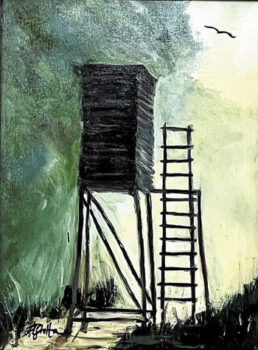
“Duck Blind” by Emily Grotta is one of the oil paintings that will be on display this summer.
Emily Grotta
Take a trip to a museum anywhere in the world and you will find yourself face to face with oil paintings. The only medium available to the masters, oils continue to be popular today with artists because of their unique qualities. And yet, many artists today avoid them because they are slower to dry and cleaning up is more difficult.
This summer, works by six oil painters in the PebbleCreek Art Club will be featured at the Creative Arts Center (CAC) and the two clubhouses, unless construction begins on the CAC before then. Tom Gallob, Emily Grotta, Diana Ho, Candis Kloverstrom, Marilyn Price, and Monica Rozwadski each chose to paint in oil for a variety of reasons, and their works reflect the broad range of possibilities of the medium. Their works will be on display June 1 through Sept. 30.
Oil paints are vibrant and long lasting; the ability to mix virtually any color from the three primary colors—yellow, red, and blue—plus white make them particularly attractive. And various techniques for applying the paint make illusions of depth and character easier to achieve. However, because they dry slowly, there are basic rules any oil painter must learn to be successful.
The first is to remember to paint “Thick Over Thin.” Oil paints are generally applied in several layers, starting with very thin layers, in which the paint is thinned with a medium, which leads to a fairly quick drying time. Subsequent layers are painted in increasing thickness, as oil paint doesn’t dry by evaporation but by “curing,” or solidifying through oxidation. Because of this longer drying period, most oil painters will have several paintings “in process.”
The second rule is “Fat Over Lean,” which refers to the type of additive added to the paint. Solvents such as mineral spirits and turpentine thin the paint, while linseed oil and other oils made the paint smoother and easier to paint with. So again, remembering that each layer needs to dry before an additional layer is added, the first layers of paint are thinned with a solvent, and then subsequent layers are added with an oil-laden paint.
The third rule oil painters need to remember is that not all colors dry at the same speed, so different areas of a painting applied at the same time will be drying at different speeds.
While this sounds complicated, trial and error and attention to detail reward the painter with gorgeous, long-lasting paintings.
The PebbleCreek Art Club invites anyone who wants to learn more about oil painting to take classes and attend open studios, where painters help each other with techniques and guidance.
